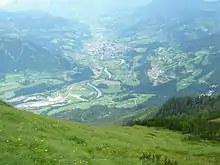St Johann im Pongau
St. Johann im Pongau (Saiga Håns or Sainig Håns in the local Pongau dialect, abbreviated St.Johann/Pg.) is a city in the state of Salzburg, Austria. It is the administrative centre of the St. Johann im Pongau District.
Sankt Johann im Pongau | |
|---|---|
 Exterior View of the Cathedral of St. Johann | |
 Coat of arms | |
 Sankt Johann im Pongau Location within Austria | |
| Coordinates: 47°21′N 13°12′E | |
| Country | Austria |
| State | Salzburg |
| District | Pongau |
| Government | |
| • Mayor | Günther Mitterer (ÖVP) |
| Area | |
| • Total | 78.14 km2 (30.17 sq mi) |
| Elevation | 565−618 m (−1,463 ft) |
| Population (2018-01-01)[2] | |
| • Total | 10,944 |
| • Density | 140/km2 (360/sq mi) |
| Time zone | UTC+1 (CET) |
| • Summer (DST) | UTC+2 (CEST) |
| Postal code | 5600 |
| Area code | 06412 |
| Vehicle registration | JO |
| Website | stjohannimpongau.at |
Geography


The city is located in the Salzach Valley of the Eastern Alps, between the Salzburg Slate Alps in the north, the Radstadt Tauern (part of the Niedere Tauern range) in the southeast, and the Ankogel Group (Hohe Tauern) in the southwest.
The city lies in the centre of the Salzburg Pongau region. The municipal area consists of cadastral communities of Ginau, Hallmoos, Maschl, Einöden, Plankenau, Reinbach, Rettenstein, St. Johann, and Urreiting.
The setting of the city, allows the area to be largely dependent on tourism, Alpine skiing in winter and hiking in the summer months. A gorge called Liechtensteinklamm lies south of the city. This gorge is about 4 kilometres (2.5 mi) long and can be explored via walkways, first built by Prince Johann II of Liechtenstein in 1875.
History
The Salzach Valley, an ancient copper mining area, has been settled at least since the Bronze Age. The settlement was first mentioned as Sanctum Johannem in Villa in a 1074 deed, named after John the Baptist. For centuries, it was a possession held by the Prince-Archbishops of Salzburg.
In the course of the German Peasants' War of 1525/26, large parts of the population became Protestant. Under the rule of Prince-Archbishop Count Leopold Anton von Firmian in 1731, numerous inhabitants (called Exulanten) were forced to leave the country. Many of them found refuge in the Kingdom of Prussia, choosing to settle in East Prussia (Gumbinnen).
In 1939, during the Austrian Anschluss to Nazi Germany, St. Johann was renamed Markt Pongau and from 1941 was the site of the World War II Stalag XVIII C (317) internment camp run by the Wehrmacht armed forces. Mainly French and Red Army POWs were interred here. About 4,000 Soviet inmates were killed or succumbed to the conditions of their detention. A 'Russian Cemetery' and a monument to this camp are located on the north end of the city.
About 20km north of St. Johann, a small portion of a picnic scene from The Sound of Music was filmed on a hillside, in the Pongau city of Werfen. Julie Andrews and crew filmed the opening shots of the "Do-Re-Mi" sequence with the Burg Hohenwerfen in the background.[3] Werfen was also the location for some filming of Where Eagles Dare.
On 24 June 2000 St. Johann completed the Stadtserhebung process and received official city privileges from the Austrian government.
Personalities
- Gerald Mild (born 1962), tennis player
- Petra Kronberger (born 1969), skier
- Iris Strubegger (born 1984), model
- Joachim Puchner (born 1987), skier
- Mirjam Puchner (born 1992), skier
References
- "Dauersiedlungsraum der Gemeinden Politischen Bezirke und Bundesländer - Gebietsstand 1.1.2018". Statistics Austria. Retrieved 10 March 2019.
- "Einwohnerzahl 1.1.2018 nach Gemeinden mit Status, Gebietsstand 1.1.2018". Statistics Austria. Retrieved 9 March 2019.
- See "The Sound of Music Filming Locations" at The Worldwide Guide to Movie Locations. http://www.movie-locations.com/intromovies/soundmusic.html. Accessed 27 March 2007.
External links
![]() Media related to St. Johann im Pongau at Wikimedia Commons
Media related to St. Johann im Pongau at Wikimedia Commons
Gallery
 Sankt Johann im Pongau, view to the town from the station
Sankt Johann im Pongau, view to the town from the station Sankt Johann im Pongau, street near the town hall
Sankt Johann im Pongau, street near the town hall
